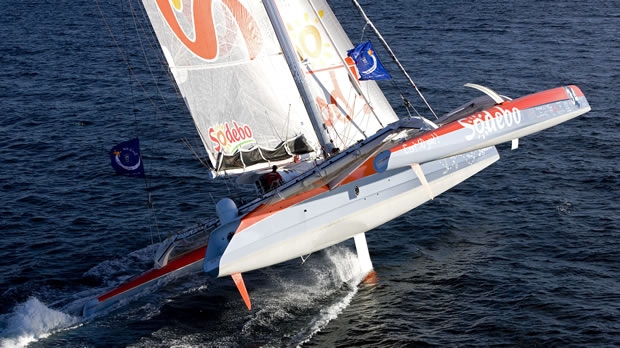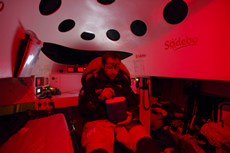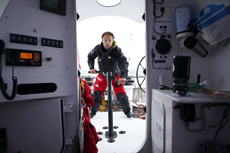
Route du Rhum race favourite?
Thomas Coville and his 105ft trimaran Sodebo will set out from St Malo on the Route du Rhum in 12 days time as one of the favourites in the Ultimate Class, the new anything-goes multihull division in France’s most historic of singlehanded ocean races.
 For Coville is one of the most successful solo offshore sailors. He currently holds the record for the west to east crossing of the North Atlantic with a time of 5 days 19 hours and 30 minutes, and he is also the fastest solo offshore sailor on the planet having managed 628.5 nm in 24 hours at an average speed of 26.2 knots. He has also huge credentials in crewed multihull sailing - he was lapped the planet with Oliver de Kersauson on board Sport Elec in the Jules Verne Trophy and was also with Franck Cammas on Groupama 3 when she set the current Jules Verne Trophy record this spring.
For Coville is one of the most successful solo offshore sailors. He currently holds the record for the west to east crossing of the North Atlantic with a time of 5 days 19 hours and 30 minutes, and he is also the fastest solo offshore sailor on the planet having managed 628.5 nm in 24 hours at an average speed of 26.2 knots. He has also huge credentials in crewed multihull sailing - he was lapped the planet with Oliver de Kersauson on board Sport Elec in the Jules Verne Trophy and was also with Franck Cammas on Groupama 3 when she set the current Jules Verne Trophy record this spring.
Yet Coville is relatively rare among French offshore multihull sailors in having a long background in monohull racing, having previously competed in the America's Cup in 1995 aboard France 2 and 3, as well as in Sydney-Hobarts and Kenwood Cups, in the Vendee Globe when he finished sixth in 2000 and in the Volvo Ocean Race, having sailed a leg of the 2000-1 event with Knut Frostad's djuice dragons. In short there can be few other sailors who have ticked as many boxes in our diverse sport as he has.
Coville is extremely enthusiastic about the prospect of lining up with the other boats in the Ultimate Class. “I think we are back to the first idea of the Route du Rhum which Mr Etevenon created – that everyone can come to the Route du Rhum and the first guy who crosses the line is the winner and that’s it - the end of the rules! So it is very clear for everybody. It is definitely the original idea of the Route du Rhum and it was originally the idea for the classes like the Open 60. It is coming back to liberty and the freedom to sail on any boats.”
This has also been Bruno Peyron’s philosophy for The Race, but Coville agrees that perhaps the limit-free type classes work best for singlehanded races, where the contribution to the boat in the end result is much reduced: much more is down to the individual sailor and their ability to handle whatever boat it is they choose to sail. “The first rule is you are going to be by yourself and you can come with any boat you want. I agree that even if there are two guys on board or more than two it is definitely not the same idea and it is probably better to get some rules to limit the length.”
The competition in the Route du Rhum’s Ultimate is set to be between five boats. These are the Irens-Cabaret trio of Coville’s Sodebo, Francis Joyon’s IDEC and Sidney Gavignet’s Majan Oman Air, while Franck Cammas is racing his Jules Verne Trophy record holder Groupama 3, albeit remoded slightly for solo racing and Yann Guichard will be aboard Baron Benjamin de Rothschild’s Gitana XI, which as an ORMA 60 won the 2006 race in the hands of Lionel Lemonchois, but has since been elongated to 77ft.
“In the last two or three Route du Rhums all of us [with the exception of Gavignet] were in ORMA 60s, so all the boats were pretty much equal in conception and speed,” says Coville. “This time they will be really different in terms of speed and also manoeuvring ability and then there are the skippers, so it is very exciting. Things will change during the race. Sometimes Gitana will be very optimised for the conditions and at other times Sodebo and then Groupama and then you have challengers like Sidney Gavignet. So it will be a very open race.”
In his preparation for the Route du Rhum, Coville has attempted to optimise Sodebo to take on the competition. Sodebo has been fitted with more powerful, larger chord foils to order to compete with Cammas’ powerful Groupama 3 when the going gets tough, particularly downwind and reaching. “They are very curved and have a big surface and we can change their incidence by moving the box,” says Coville of his new foils. To be able to use the power of the foils, Sodebo’s sail area has been increased by 15% in order to be competitive against Gitana XI in light to medium conditions.
“Our best point is that I have been sailing a lot on my boat so I know it perfectly,” says Coville who reckons he has around 75,000 miles alone on his red three hulled steed already. “So that is a good point for the Route du Rhum but we also improved the boat in pretty much all the conditions.”
Once again they have been hunting to save weight throughout the boat and for example shed 200kg by changing to Li-Ion batteries. Coville reckons Sodebo is now 500kg lighter than she was in round the world trim, or “closer to 12 tonnes”.
Coville says that he has also been working extensively with B&G on his autopilot system. “Actually we have improved all the systems - better compass data and better wind direction data and also using much better the B&G pilot and the new software. We have been building software to be sure we are always at 100% efficiency with the autopilot. It was nearly two years of development. We know all the time the three dimensional position of the boat and we can send that to the autopilot.”
A more efficient autopilot means that there is less onus on Coville to steer compared to the old days with the ORMA 60. “Then you were so much better than the autopilot. I would say now it is better and better. You are better to trim the sails all the time and be able to have the best course all the time rather than steering.”
In terms of the handling Coville says that Sodebo may have around a third more sail area than his ORMA 60 had, but the manoeuvring is otherwise much the same. “It takes a bit more time whenever you want to manoeuvre, but even if you want to move the sails like the genniker or the Code 0 it is not that heavy.” Yeah, right!
Sodebo’s sail inventory comprises a main, big genniker, genoa/Solent, staysail and storm jib, although he says he will look at the weather for the first three days to decide on whether he takes an additional Code 0 if conditions look light or if he carries an spare genniker. While the staysail and solent are permanently hoisted, the storm jib and genniker are manually hoisted.
The Irens-Cabaret trio are significantly heavier than an ORMA 60 (around 12 tonnes compared to 7) but Coville says you don’t really notice it. But the biggest difference between the new Sodebo and Coville’s previous ORMA 60 is the substantial hike length, compared to the marginal increase in power - sail area, a lower CoE sail plan and with a narrower beam there is actually less righting moment available than the 60. “The length is of course a big advantage for the safety and to be honest I have never felt I could capsize over the front,” says Coville. “Maybe the bad point is that we are not that wide compared to the 60s which were pretty much square.”
The end result is a substantial increase in performance. Thanks to their higher power to weight ratio, ORMA 60s may still be capable of higher peak speeds but the longer, heavier boats are more capable of forging through waves in stronger conditions and as a result 550-600+ mile days are more a matter of course, while they are flat out and on the edge in a 60.
Singlehanded non-stop around the world in multihulls
Somewhile back the organisers of the Route du Rhum announced they were planning a singlehanded non-stop round the world race for the Ultimate class to be held in 2011, but this doesn't seem likely to come to pass, at least not in 2011. However this remains the last big yacht race around the planet yet to be staged and it is a question of ‘when, not if’ it will happen.
While there is a general lack of appetite for this race among the ex-ORMA skippers, Coville at present seems to be the only skipper enthusiastic about the prospect of such an event. “I really hope that after the Route du Rhum some guys realise that it is time to do that ultimate race going around the world in any kind of boat, like we did 20 years with the Vendee Globe. Everyone thought it was crazy back then and no one could do it. Now with the size of the boats and the speed of the boat the most ultimate race is round the world, not just the Atlantic. Hopefully it will happen before I get too old!”
What is needed are a new generation of Bourgnons or Ravussins, the apparently fearless Swiss ORMA 60 sailors of the 1990s, to take up the challenge. “But this Swiss guy is building something else!” jokes Coville of Steve Ravussin who is involved with the development of the MOD70. Both Coville and Ravussin sailed together on Groupama 3 earlier this year as part of Franck Cammas’ crew on the Jules Verne Trophy record. “I told Steve during the Jules Verne –you should have waited two or three years as what you are organising is something for our retirement! It is a good idea, but it is not time yet!”
More images from Thierry Martinez/www.thmartinez.com/Sea & Co
Images from Christophe Launay/www.sealaunay.com
 |
 |
 |
 |
 |
 |
 |
 |
 |
 |
 |
 |
 |
|

















Latest Comments
Add a comment - Members log in